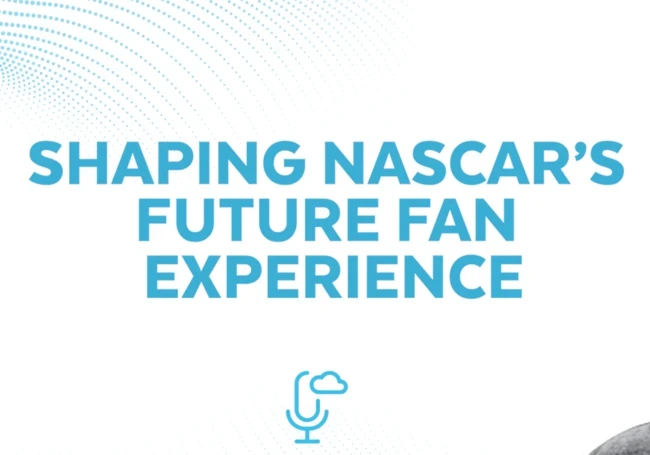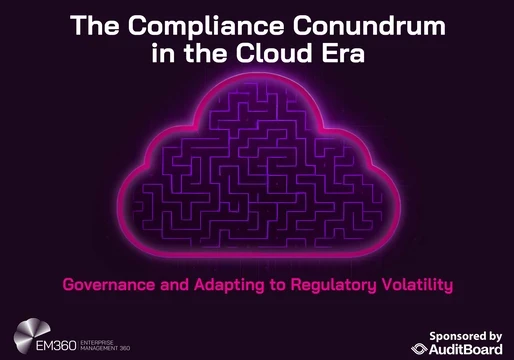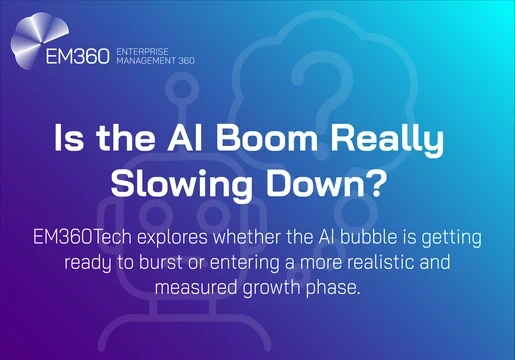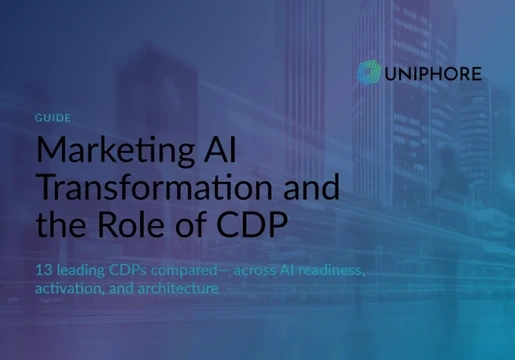This interview features Clay Owensby, Senior Director of Data and BI Technology at NASCAR, hosted by Dana Gardner, Principal Analyst at Interarbor Solutions.

We dive into how NASCAR leverages advanced data analytics and digital services to enhance fan engagement and safety, modernize their data architecture with cloud solutions, and foster a deeper relationship with fans. The conversation also covers the popular organization's strategy for attracting younger audiences -- and the potential future benefits of predictive analytics and AI in delivering personalized experiences.
[Listen to the discussion or watch it.]
Dana Gardner: Welcome to the Data Cloud podcast, Clay. We're delighted to have you with us.
Clay Owensby: Thanks for having me.
Dana Gardner: Clay, you've said that NASCAR isn't just about selling tickets to events anymore. It's more about re-imagining what a sports league can be. What do you mean by a sports league? And tell us how you've been making the transformation from events to something much larger.
Clay Owensby: When we think of NASCAR and going to a race, it’s more than buying tickets to an event. NASCAR has embraced the experiential part of it -- having our fans enjoy a full gamut of experiences: from meeting our drivers, to being in the pits, to seeing the cars, and our amazing kids' experiences around the track.
And let's not forget that the tracks themselves are amazing spectacles to behold. They're so enormous, huge, and a lot goes into a NASCAR race. A lot of people, they really don't realize, the old jokes about just going around in circles -- it's much more, a very wide range of experiences and a great for the entire family. NASCAR has evolved from the ideology of sitting down and watching cars go in circles to this amazing experience at these world-class facilities to shaking hands with a race car driver. That’s just amazing.
Dana Gardner: Yes, and a lot of sports tend to dwell on statistics and give you lots of ways to slice and dice your team, your driver, your favorite. But when it comes to a car, you have an amazing high-technology endpoint that's generating tons of digital data. It seems to me that there's probably no better sport to be digitally geared toward.
Clay Owensby: These machines are amazing. They really are. And the technology that goes into these machines -- from the analytics on the engine temperature, the tire pressure, all of these type of metrics – to the safety ratings of the cars themselves and keeping our drivers safe as they're barreling around these tracks.
On our super speedways, it is nearly 200 miles an hour around a track. And keeping those drivers safe is one of our top priorities. And so not only is the technology just incredible in what makes the car go, but also the technology around keeping the driver safe: Everyone in the sand safe, the pit crews, everyone around these cars.
Dana Gardner: So an opportunity to geek out in a big way, the technology as well as the competitive nature of the sport. Tell us how, in getting to these fuller set of services, does modern data analytics and IT help bring all of the experiences together.
Clay Owensby: There are a lot of IT terms, from data automation to business intelligence (BI). But when you peel back the onion and start to think about data and what it takes to drive the analytics, the foundation is really the key. Just like a house, if you can build a firm foundation, you're going to have a strong house and it’s just in a data architecture. If you can build an immovable foundation that you can consolidate data, transform data, and do all kinds of things.
You can democratize data from this foundation, and then sky's the limit. So, centralizing the data in a strong foundation allows us to share the data across the many aspects of generating the best experiences that you just mentioned.
Dana Gardner: And when the fans leave the racetrack, you can engage with them through a lot of these digital services, give them the types of geeking out that they prefer and want. Then they're going to be able to tell you more about themselves and what they want. And you can have a full-time, ongoing relationship that feeds more data into the services, that creates a better bond, that then creates a virtuous adoption cycle.
So it's not only a foundation, but it's innovation into a whole new set of services.
Clay Owensby: Absolutely. That all bakes into that fan experience. The fan experience doesn't end when they leave the racetrack. Just as you mentioned, it follows them with their mobile app to NASCAR.com and down the road to the next race. And the next race. And the next race. And sitting in their living rooms, watching NASCAR on television.
Dana Gardner: Well, let's learn a little bit more about you, Clay. Tell us about your role at NASCAR, your background, how you got there, and how data science is important to you on seizing on these many opportunities.
Clay Owensby: I've been with NASCAR for 10 years. I was hired here to work on our ticketing platform and have been involved in the data. I knew at that point that I was interested in data and I knew that data was the core foundation for everything I was doing.
From there, I grew into my role and cut my teeth through the years of multiple iterations, learning and iterating through different formats of our enterprise data warehouse.
I really focus on the fan, the fan data, and the behaviors. Through the years it's been very heavily around ticketing -- understanding those buying patterns to each of our races and following that fan through their journey to attend our races. But now it’s more about looking at that fan holistically in their behaviors across social, merchandise sales, how we engage with these fans, and what is the best way to engage.
It now means predictive analytics, because that's as a company where we are holding strong on our opportunities. That's not to say that AI is not here because it certainly is and we're using it in a big way in those terms. But our opportunities are coming via these predictive analytics and learning how and what and when and where to engage with our fans.
Part of that experience is identifying what a fan is engaging in. We have a lot of different events at our venues. We have motorcycles, cars, and different series of cars. We have our sports car series with IMSA, and then our stock car with NASCAR. We also have motorcycles.
So, if someone's really into sports cars, we certainly want to engage with them on a sports car basis, right? We want to make sure they have the data at their fingertips. In the case that NASCAR is on their list, we really want to make sure that that experience and that personalized experience is there for that fan.
Dana Gardner: Let’s drill in more on how you do these analytics to be predictive and realize more opportunities. But I have to tell you, I have a personal insight.
I live within 10 miles of a major speedway and in fact, there's a NASCAR race this weekendthere. And I have to tell you, I've noticed that people start coming into the area for these events from a tremendous distance a week or more in advance, and then they stay for quite a while. And it's a lifestyle. This is not just going to an event. These people live this thing, and they spend a lot of money, and they consume a lot of services and share great camaraderie. We're talking about a devoted and enthusiastic fan base.
You're the number one motor sport provider in the US and also internationally. I can't imagine another fan base quite as devoted as yours.
Clay Owensby: I have never seen anything like it. I grew up in athletics from a football perspective and tailgating. You show up on Saturday for your game, perhaps come into town on Friday. You set up your tailgate. That's amazing.
But as you mentioned, our speedway fans come onto our racetracks and they build an entire city. They bring their campers and, they camp and they tailgate for weeks at a time. It is amazing. These fans are the most amazing I've ever seen.
I mean, they are passionate, they are loyal, and they're the core of our sport. The fans drive the sport, and there is just nothing like it. If you've never been to a NASCAR race, don’t just go to the stands, go into the campgrounds. That should be on your bucket list and for all the listeners as well. You will never see anything like it.
Dana Gardner: Clearly, given what we've just described, you've been doing something right for quite a while. But now you have this awesome base to work with and bring them into even more digital activities -- things like AI and augmented reality, feeling like they're in the race car. It's a tremendous additional opportunity.
Tell us about what the data architecture that supports that foundation you described that then gives you these outcomes that are unprecedented in sports, really. Tell us about your data garage. What does that phrase mean?
Clay Owensby: The NASCAR term data garage was coined six years ago through our conversations to empower data more and more and more across the board. We recognized that we needed to reimagine what the NASCAR data landscape is from a fan perspective. And we wanted to future-proof what we were doing.
And the people around the data foundation are key here. Then we started with the tools, and from there -- I was an early adopter of this team – as we began looking and building the people – the team. Then the tools came in and that idea of the foundation that's best in class, it's going to last ,and that we have a vendor and a partner that can grow with us and work with us.
That was our strategy, and we landed with Snowflake being our foundation, our core, where we were going to move, and centralize our data. We knew that we wanted to centralize it, and we knew early on that we had an uphill battle with silos and that that was another one of those key initiatives that was it going to be a long-term initiative.
From there, Snowflake came on. And then all of the things around your governance, your segmentation, your democratization, your BI platforms, we really started going down the road with GrowthLoop as one of the partners to grow with us, and they certainly did.
And they're still here today and we utilize Tableau as our BI tool. And from there we started at a core. And then have continued to evolve through those tools, and of going from a mostly on-premises to going through the cloud revolution of moving everything to the cloud and cloud computing.
Those were our first steps because we knew that the efficiencies and the scale were there and we needed to tap into that. And these partners that we chose have been instrumental to our evolution, our growth, and where we are today. I firmly believe that we would not be nearly as far as we are today without the Snowflakes and others that helped along the way.
Dana Gardner: I think NASCAR is a poster child for cloud computing because your locations shift so dramatically. And it's literally like picking up an entire city, as you say, and then plopping it down another place, hundreds of miles away, with hundreds of thousands of people attending. How else could you possibly do this without the cloud model?
So the data garage is your data warehouse, is that correct? Is that how I should understand it?
Clay Owensby: That's correct.
Dana Gardner: How do you improve scalability and automation? Now that you've gotten that foundation and centralization, how do you balance the good parts of centralization with the need for the decentralization and allowing that democratization of data and services?
Clay Owensby: That's a good question That's where we are today, honestly, just breaking down silos on a daily basis, centralizing more and more data, bringing it together and figuring out how to deliver it across our business. And not only democratizing data within our walls. But then through data shares, APIs, and other things.
We are making handshakes with our partners and with internal stakeholders of democratizing the insights that we have gathered and making the predictions through our data science and warming the business up to the idea of these predictions and the value that these predictions can bring to the company.
A few years ago, it would take weeks and weeks to train a model and make these predictions. But with cloud computing and Snowflake and all the tools we can train a model in an hour and retrieve predictions and begin to quickly make more predictions and retrain again.
It’s all about build, learn, iterate, because that's where we are and where we'll stay. If we get a prediction that we're not quite comfortable with, then we go back to engineering and we rerun the model in an hour and say, “That's exactly what we needed, and now we're good.”
And then we can push the predictions out across our business and begin to educate our business on what predictions can do for us and what these catchphrases of data-driven decisions are and how we can impact and influence. And let's not forget the efficiencies that it brings to the people around us.
Dana Gardner: Yes. Clay, I’m curious when you try to bring this out to more aspects of your overall complex business, people out in the field aren't necessarily going to be good at Boolean queries. And so are you getting also a natural language approach to how people can interact with the models?
How is the usability factor playing into the ability for your predictions to be consumed easily and well?
Clay Owensby: We’re looking at tools like Snowflake Cortex and seeing how we can push some of the data points out in a format that that's easy to use and where you can go in in natural language and just ask.
We went through the BI approach, and the BI approach is there, but we still found that in the democratization through BI that some of our users would come to us and say, “Hey, the reports are complex. I'm going to break something.”
And through education, we've managed through it. But to your point, in the outlook of pulling in a Cortex to transition to natural language where someone can come in and say, “How many tickets did we sell to the Daytona 500 in 2025?”
We're testing with Snowflake and we're making sure that through the natural language questions that we are encompassing all of our business rules. There are a lot of business rules and there are a lot of intricacies that exist in a grandstand as you look at one for a seat. And we want to make sure that we are following our rules.
In looking into these natural language search engines, I read a lot that the complexities around the inventories and this type of thing in a sports language, in a stadium, that it makes it difficult. And it does, and it's going back to the people there internally that we have to work with at Snowflake to make sure that we have our data structured properly to be able to answer the questions accurately. And that's really where we are in our efforts today.
Dana Gardner: How do business outcomes benefit from these investments in analytics and warehousing? Does your Data Garage and doing predictive analytics extend out across your organization?
For example, one of those business benefits, it seems to me, is being able to identify and attract new segments in the market to NASCAR.
Now, I grew up during the 1960s and 1970s, and so car culture was very much a part of all of our lives. But I have to tell you, my kids not so much. The car is not such a mythical entity as it was for us when we grew up. A car was synonymous with freedom.
For young people now, it's just a tool. But you're going to need to get younger fans involved with NASCAR. So how can you show a business benefit through your activities in terms of attracting and getting a younger audience involved?
Clay Owensby: With our data science, we have a fan score. And we can separate out the types of fans we are seeing. It's based on behaviors. And we have new fans, we have bucket listers, and we try to look at these types of fans that we've identified and we try to engage with them.
And when I say engage, I mean how to communicate, what to communicate with those fans. And we try to stay engaged as much as our model says they want to stay engaged. With NASCAR and some of the changes we've made over the last year, we took some of ourproductions to Amazon Prime. And that certainly brought us a younger demographic.
There we're also into the gaming area where we have some games development and we have a group that works on that, and they do a great job through Roblox and our official NASCAR game. So really when I think about, you know, the attraction of that next generation of race fans.
But you hit on one of our north stars of the company. Everything that we do lends itself to identifying what a fan looks like. And as we go across all of the different mediums from social media to the games, to the people coming to the tracks, because certainly people come out with their children and we do the NASCAR experience and we have a kids club where the kids can come out and they sign a car and my children love it.
But there is absolutely nothing like coming to a racetrack and bringing your children and experiencing a race. Because that is really the second you get hooked is when you experience all the sight, the sounds, the feels, right, of a race.
Dana Gardner: And as you've generated this great foundation and gotten into the analytics, what are some of the things you've learned about that fan base? Maybe that there's so many different personas or some of the ways and reasons that people are devoted. What have you been able to learn that wouldn't have been perhaps obvious before the analytics made data science a partner with in all of this?
Clay Owensby: You alluded to it earlier. I mean, being a NASCAR fan, it's a culture. They are devoted fans and they're loyal fans and they are very in tune with the sport. And they pick their drivers, and they stick with their drivers and they come out and they enjoy the experience.
And when I start thinking about analytics and things that we've found in the data that I don't know that I would've told you this, but when we see a rise in ticket sales, we've seen a direct correlation to the viewership. So, it's not if an event produces more ticket sales, less people are gonna watch it.
No, it's directly proportional where the more tickets we sell, the viewership is higher as well. And we're seeing this in the data and we're analyzing it. This is hot off the press to be honest, and we're analyzing this right now. And what we want to see is like, and this is another like point here in the data, is when you come to a NASCAR race, everybody has on their merchandise, right?
They have their driver's merchandise on. Their Chase Elliott shirts and cowboy shirts, and everybody has on their merchandise. But what we've found is the merchandise sales, it does not correlate necessarily to attending a race. So that tells us that there's a lot of merchandiseout in the world that perhaps isn't showing up at our racetrack. So we've got a lot of fans out there that we're engaging with. And it's amazing.
Dana Gardner: You're able to grow the pie regardless of the modality. That's an important to insight.
Clay Owensby: It certainly, certainly is.
Dana Gardner: We're almost out of time, but I wanted to focus on that predictive analytics and where you see this going as you're able to spin up this engine of data and insights and responses and extend your market and grow.
Where do you see it going after that? Can we put a crystal ball in front of you and say, “When you get agentic AI up and running and you're able to extend these analytics and use them across your organization, what sort of benefits services and, frankly, for the fans, entirely new experiences should they expect?”
Clay Owensby: Absolutely. So, internally, we're looking for efficiencies across the board. When it comes to FinOps to our productions, the guys working through our productions, they're doing great work through in-car cameras and a lot of the aspects of feeding the data across to the television screens. They do a wonderful job there.
That is going to continue to evolve and we're going to go back to that experience and make the fan -- if they're at the race or if they're viewing it from their television in their living room – feel like they're sitting right next to that driver in the car. Getting all the same feels, the excitement that they would as if they were sitting in a race car themselves.
So it's bringing our fans as close to the excitement as we possibly can and enhancing this experience. From there, the sky is really the limit. AI is one of those tools like the airplane, the car, the horse that we have to figure out how we're going to use and how it's going to evolve and how it's going to make us more efficient in our day to day.
And that's the power of it. And we are going to continue from a fan perspective to not only bringing them closer to being inside of a race car as we possibly can in that experience, but also delivering and engaging with them the content that they want and how they want to be engaged with, and the rate at which they want to be engaged with.
That’s through social, email, text, a call. And then with all of that also comes all of the consents and the legals and all the other words that come along with it that. AI can add on and make those avenues more efficient as well.
Dana Gardner: Modulate the risk while enhancing the experience and personalizing it as best you can.
Clay Owensby: You said it more eloquently than I.
Dana Gardner: Well, I have to say, your story sounds like not just a good case study for sports, but for any business that's looking to take data, analyze it, use it for a business benefit internally, extend that out to their audience and create that interaction, that virtuous adoption cycle.
That's the nature of growth and innovation. So congratulations on that.
Clay Owensby: Thank you.
Dana Gardner: I'm afraid we'll have to leave it there. I'd like to thank our audience as well as our latest Data Cloud Podcast guest, Clay Owenby, Senior Director of Data and BI Technology at NASCAR in Daytona Beach, Florida. Thank you so much, Clay.
Clay Owensby: Thank you. This was amazing.
Dana Gardner: We really appreciate you sharing your thoughts, experience, and expertise.
Calling all developers, business leaders, IT execs, and data scientists. Snowflake World Tour is your chance to learn and network. Discover how Snowflake's AI Data Cloud can transform your career and company. Experience the future. Join us on tour. Join the Snowflake World Tour to experience the future of the AI Data Cloud with Snowflake. Hear from experts, engage in breakout sessions, and network with peers. Transform your business and career with Snowflake. Register today for one of our 23 stops worldwide at snowflake.com/world-tour.







Comments ( 0 )